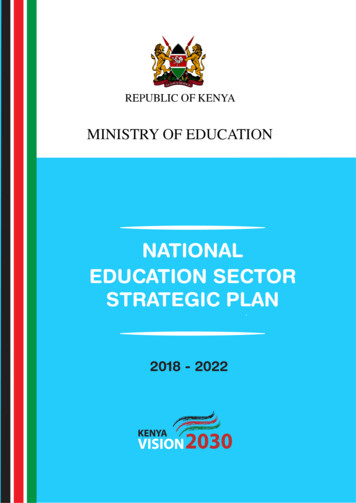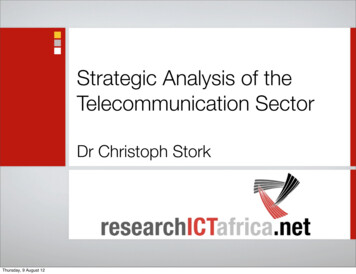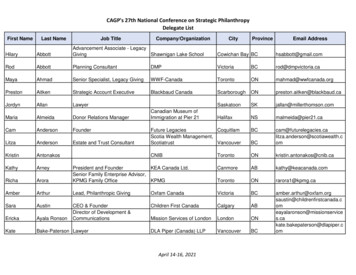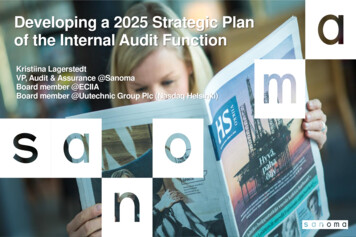
Transcription
REPUBLIC OF KENYAMINISTRY OF EDUCATIONNATIONALEDUCATION SECTORSTRATEGIC PLAN2018 - 2022
REPUBLIC OF KENYAMINISTRY OF EDUCATIONNATIONAL EDUCATION SECTOR STRATEGIC PLANFOR THE PERIOD 2018 - 2022i
VISIONQuality and inclusive education, training and research for sustainabledevelopmentMISSIONTo provide, promote and coordinate competency based equitable learnercentered education, training and research for sustainable developmentTHEMESAccess and Equity; Quality and Relevance; Governance and Accountabilityii
Table of ContentsList of Tables . vList of Figures . vLIST OF ACRONYMS AND ABBREVIATIONS . viFOREWORD . xiPREFACE AND ACKNOWLEDGEMENT . xiiEXECUTIVE SUMMARY . xivDEFINITION OF TERMS . xvii1. THE CONTEXT OF EDUCATIONAL DEVELOPMENT AND REFORMS INKENYA . 11.1 Key Demographic and Macro Economic Indicators . 11.2 Key Social Indicators . 21.3 Education in Humanitarian Context in Kenya. 31.4 Kenya’s Education Sector Structure and Policy Framework . 31.5 Structure of the Education System . 42. THE STATUS OF THE EDUCATION SECTOR AND ONGOING REFORMS . 62.1 Access and Participation. 62.1.1 Pre-Primary Education . 62.1.2 Primary Education . 72.1.3 Secondary Education . 82.1.4 Adult and Continuing Education . 92.1.5 Technical Vocational Education and Training (TVET). 102.1.6 Inclusive Education . 122.1.7 University Education . 132.1.8 Science, Technology and Innovation . 142.2 Internal Efficiency in Basic Education . 162.3 Disparities in Access to Basic Education . 172.4 Quality and Relevance of Education . 192.4.1 Student Learning Achievements . 192.4.2 Curriculum Reforms . 202.5 Teacher Education, Professional Development and Management . 212.5.1 Teacher Education . 212.5.2 Teacher Professional development . 222.5.3 Teacher Management . 232.5.4 Teacher Distribution and Utilisation . 242.5.5 Teacher School and Class Attendance . 242.6 Education Financing . 252.7 Pertinent and Contemporary Issues and Values . 263. STRATEGIC DIRECTION AND PROGRAMME DESIGN. 293.1 NESSP Programme Design Causal Linkages. 293.2 Sub-Sector Programmes and Activities . 313.2.1 Governance and Accountability . 313.2.2 Pre-Primary Education . 37iii
3.2.3 Primary Education . 413.2.4 Secondary Education . 463.2.5 Adult and Continuing Education . 513.2.6 Inclusive Education for Learners and Trainees with Disabilities at BasicEducation . 543.2.7 Teacher Education, Professional Development and Management . 583.2.8 Technical and Vocational Education and Training (TVET) . 623.2.9 University Sub-Sector . 683.2.10 Science Technology and Innovation Sub-Sector . 723.2.11 Post Training and Skills Development . 763.2.12 Quality Assurance and Standards . 783.2.13 Kenya National Qualifications Framework (KNQF) . 793.2.14 Cross Cutting and Contemporary Issues . 804. COST AND FINANCING OF NESSP . 841.1 Simulation Parameters and Targets . 841.2 Cost of Implementing the Plan . 871.3 Resourcing the Sector Plan . 905. IMPLEMENTATION ARRANGEMENTS, MONITORING, EVALUATION ANDRISKS . 915.1 Implementation Arrangements . 915.2 Institutional Framework and Responsibilities of Monitoring and Evaluation . 915.3 Key Principles . 925.4 Monitoring Indicators . 925.5 Reviews . 935.6 Instruments . 935.7 Major Assumptions, Risks and Mitigation Strategies . 93iv
List of TablesTable 1: Total Population and Gross Domestic Product, 2013-2018 . 2Table 2: Government Resources and Spending . 3Table 3: Kenya Basic Social Indicators . 3Table 4 :Trends in Pre-primary Sub-Sector . 7Table 5: Trends in Primary Sub-Sector . 8Table 6: Trends in Secondary Education Sub-Sector . 9Table 7: Enrolment Trends in TVET 2013-2018 . 11Table 8: Enrolment by Gender in Universities (2013/14 - 2016/17) . 13Table 9: Quality and Relevance of Education . 19Table 10: Graduates from Teacher Training Colleges . 22Table 11: Net Projections on Teacher Shortages -2019-2023 . 22Table 12: Teachers Employed by Boards of Management . 23Table 13: Government Expenditure on Education, 2010/11-2015/16 (Current Prices) . 24Table 14: Macroeconomic Forecast . 81Table 15: Simulation Parameters and Results . 82Table 16: Total Resource Requirements . 85Table 17: Summary of Recurrent Costs . 85Table 18: System Strengthening Costs by Delivery Unit . 86Table 19: Summary of Capital Costs . 86Table 20: Resource Requirements and Financing Gap for the Education Sector . 87Table 21: Recurrent Resource Requirements and Financing Gap for Education Sector . 87Table 23: Possible Risks and Mitigation Strategies . 91List of FiguresFigure 1: : Structure of the New Education System in Kenya . 5Figure 2: Education and Training Progression Pathways . 6Figure 3: Adult and Continuing Education Enrolment Trends in Kenya . 10Figure 4: Trends in Survival Rates and Promotion and Repetition Rates . 16Figure 5: Out of School by County in Thousands, 2014 . 16Figure 6: Disparities in Retention by Selected Counties . 17Figure 7: Trends in KCSE Performance . 19Figure 8: The Causal Chain of NESSP 2018-2022 . 27Figure 9: Evolution of Enrolments in Pre-primary and Primary . 83Figure 10: Evolution of Enrolment in Secondary and Tertiary Levels of Education . 84v
LIST OF ACRONYMS AND ABBREVIATIONSACE:Adult and Continuing EducationAIDsAcquired Immune Deficiency SyndromeAPBETAlternative Provision of Basic Education and TrainingASALArid and Semi-Arid LandsBAB:Biosafety Appeals BoardBOGsBoard of GovernorsBOMBoard of ManagementBn:BillionsCATsContinuous Assessment TestsCBACompetency Based AssessmentCBCCompetency Based CurriculumCBETCompetency Based Education and TrainingCBOsCommunity Based OrganizationsCDECounty Director of EducationCDCCenter for Disease ControlCEMASTEA:Centre for Mathematics, Science and Technology Education in AfricaCLRCCommunity Learning Resource CenterCPPMUCentral Planning and Project Monitoring UnitCQASOsCounty Quality Assurance & Standards OfficersCS:Cabinet SecretaryCSOsCurriculum Support OfficersCUE:Commission for University EducationDLPDigital Literacy ProgrammeDUCDifferentiated Unit CostEARCs:Education Assessment and Resource CentresECDEarly Childhood DevelopmentECDEEarly Childhood Development and EducationEDPCGEducation Development Partners Coordination GroupEGMAEarly Grade MathematicsEFAEducation for AllEMISEducation Management Information SystemERVPublic Expenditure Reviewvi
ESAEducation Sector AnalysisESDEducation for Sustainable DevelopmentESPEducation Sector PlanFBOsFaith Based OrganizationsFDSEFree Day Secondary EducationFMFinancial ManagementFPEFree Primary EducationFTE:Full Time EquivalentGAAPGovernance and Accountability Action PlanGDP:Gross Domestic ProductGER:Gross Enrolment RateGERD:Gross Expenditure on Research and DevelopmentGoK:Government of KenyaGPI:Gender Parity IndexGTTGovernment Trade TestG-UnitedGreatness UnitedHEHigher EducationHDI:Human Development IndexHELB:Higher Education Loans BoardHQsHeadquartersIBQAInstitutional Based Quality AssuranceICTInformation Communication and TechnologyIEInclusive EducationIECInformation Education CommunicationIERCsInclusive Education Resource CentresIFMISIntegrated Financial Management Information SystemIIEPInternational Institute of Education PlanningIPPDIntegrated Payroll Personnel DatabaseIPRIntellectual Property RightsISEMISIntegrated Skills and Employment Information SystemISOInternational Organization for Standa
i republic of kenya ministry of education national education sector strategic plan for the period 2018 - 2022











